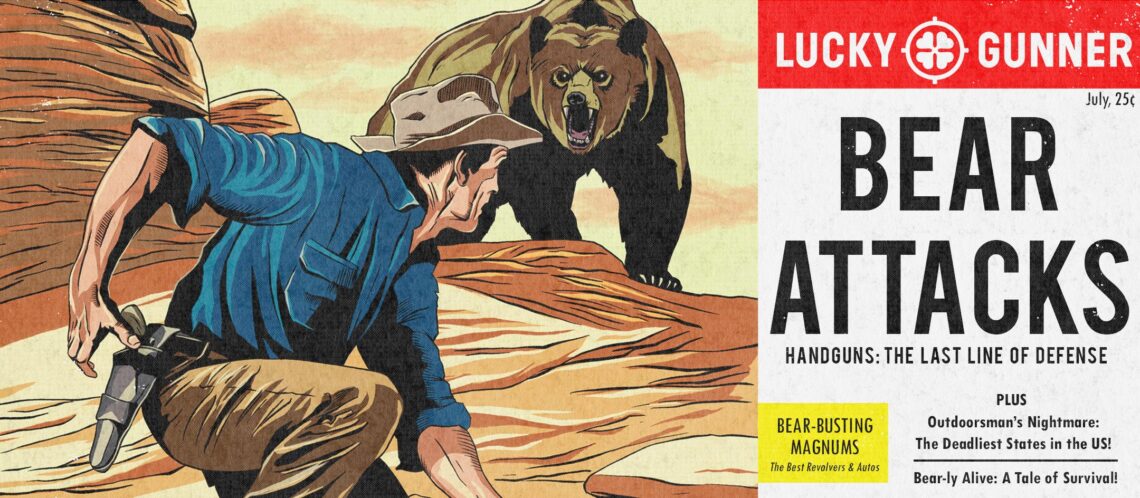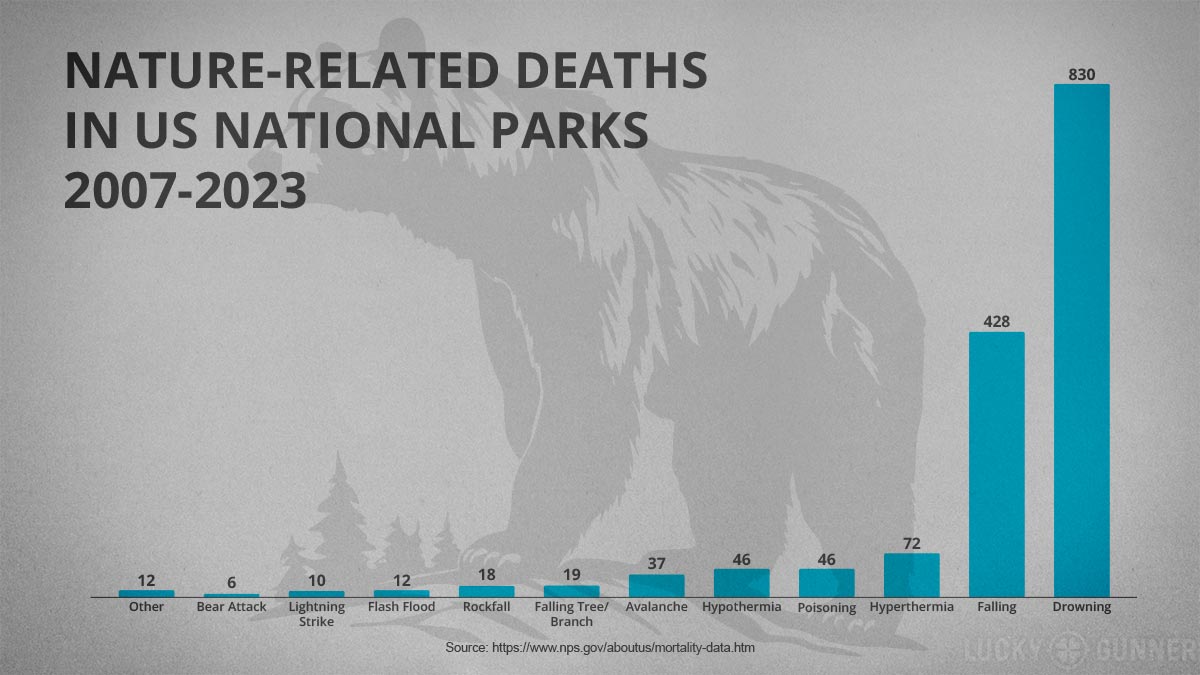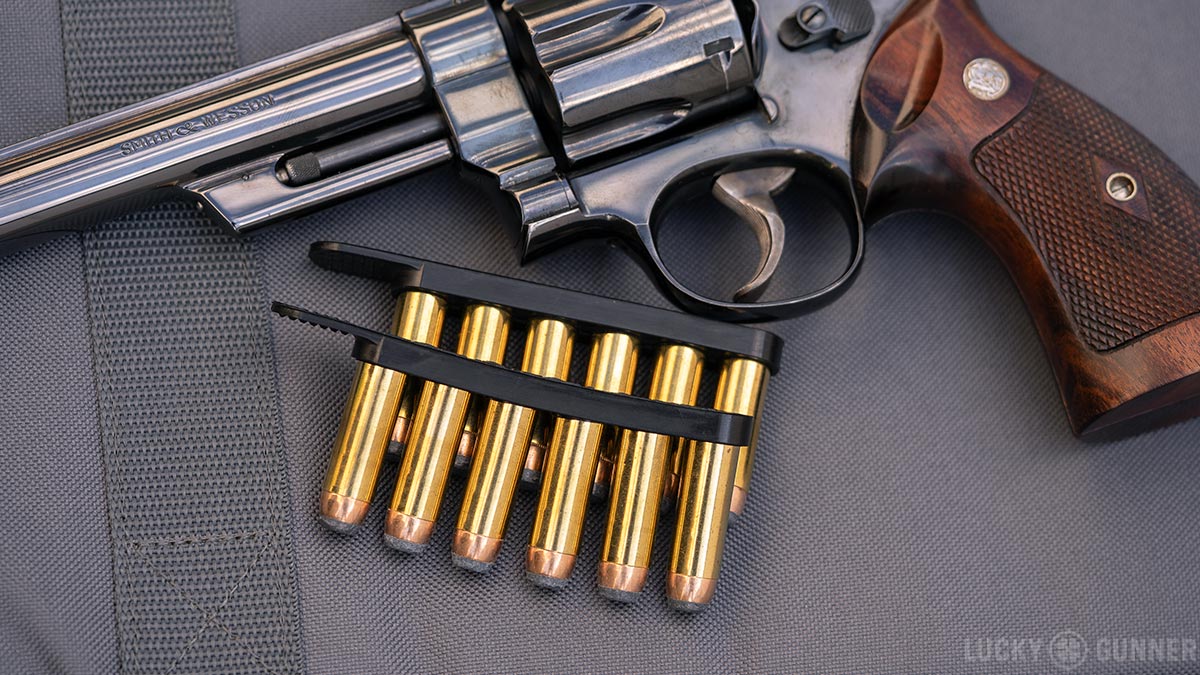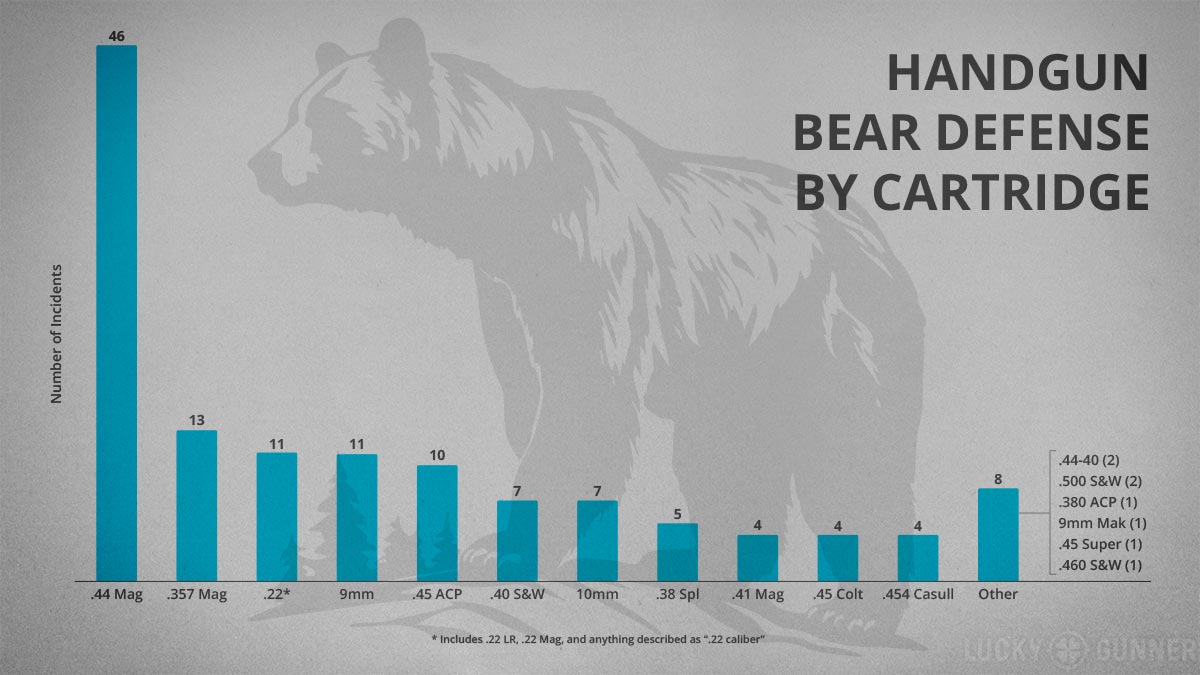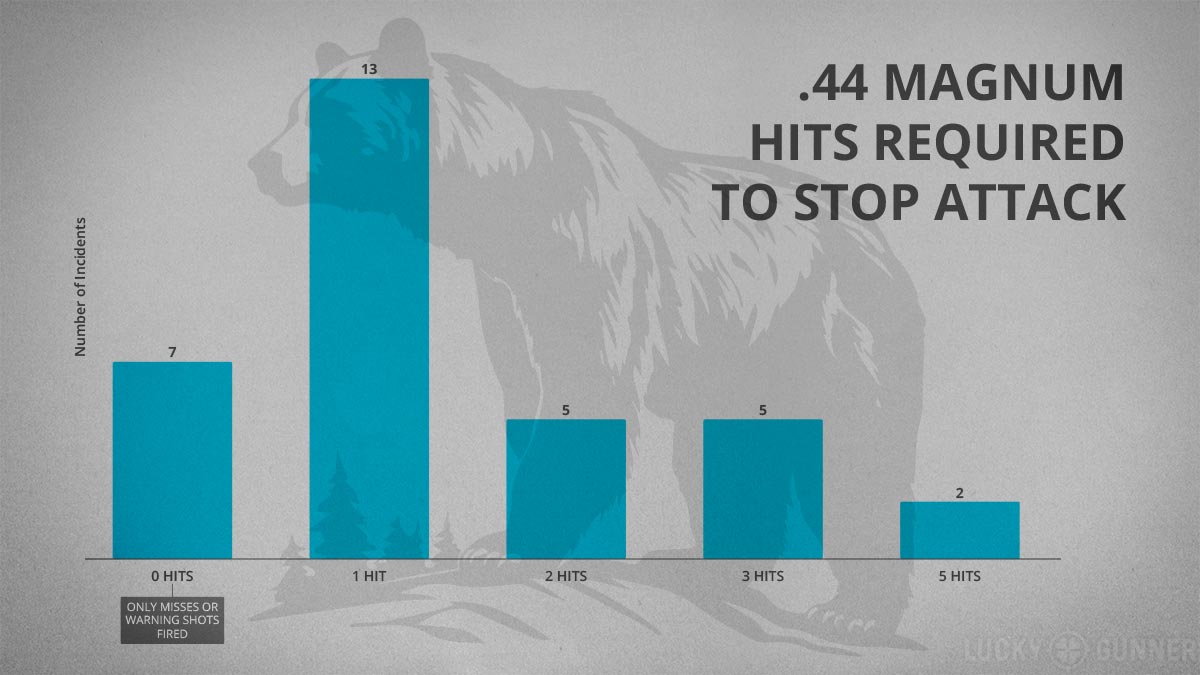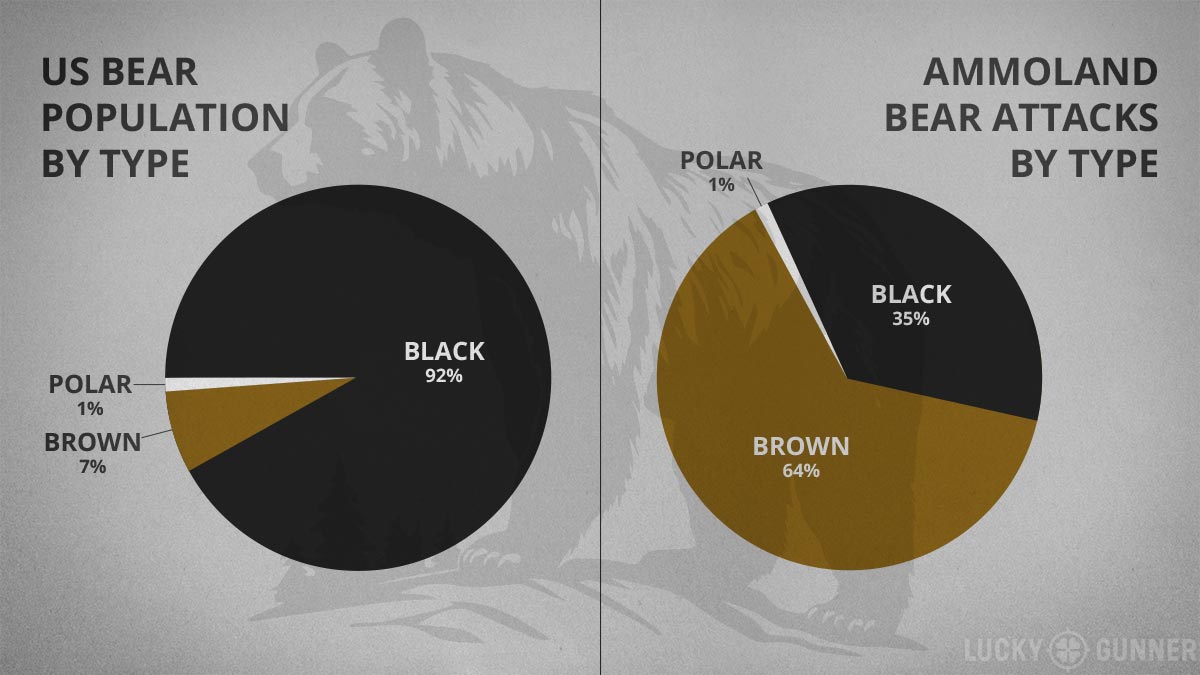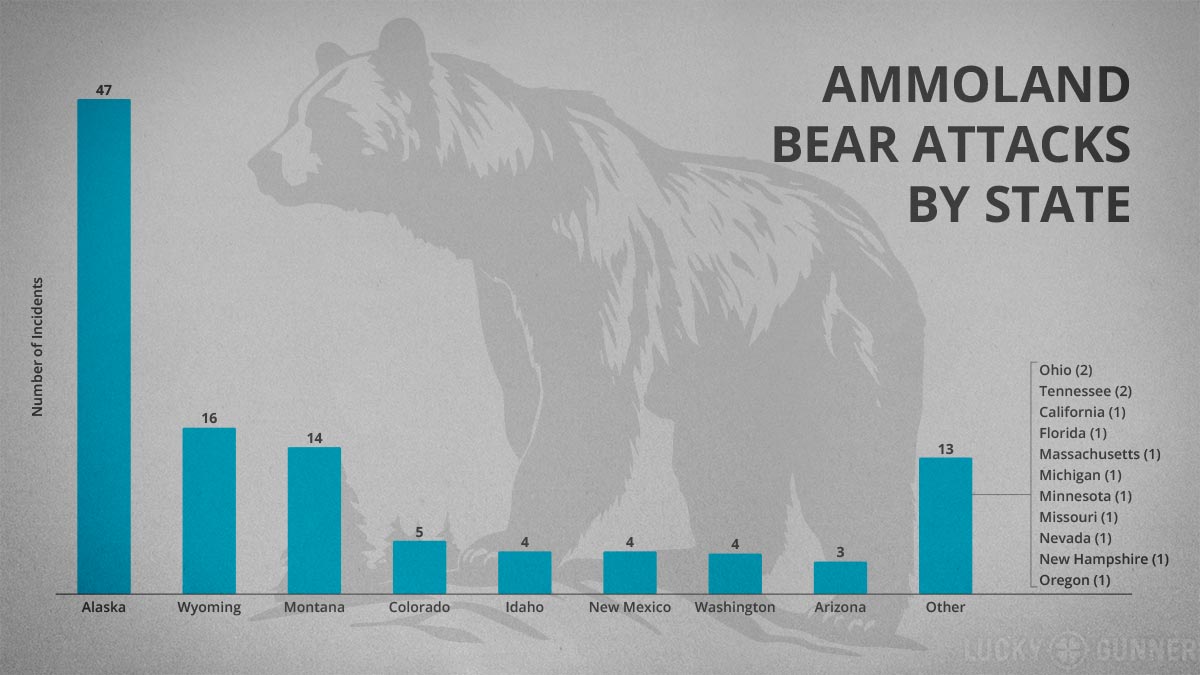By popular request, we take on the topic of using handguns for self-defense against bear attacks, drawing on 162 documented cases collected by Ammoland. We explore the effectiveness of warning shots, performance of various calibers, and stats on the likelihood of bear attacks by location.
Details are in the video below, or keep scrolling to read the full transcript.
Hey everybody, I am Chris Baker from LuckyGunner.com and today I’m going to talk about using a handgun to defend against a bear attack.
A lot of you guys have asked me to cover this topic over the years, but I’ve been reluctant. I’ve got a fairly deep well of knowledge on guns, ammo, ballistics, and self-defense. What I know about bears is more like a sippy cup of knowledge in comparison.
Fortunately, there is an excellent resource we can lean on here: the collection of handgun defenses against bear attacks compiled by the firearms news website Ammoland.com. Since 2018, they’ve been collecting every account they can find where someone has used a handgun in a bear attack. They just published their latest update in May of this year and they’re up to 162 documented cases. To be clear, we don’t have any relationship with Ammoland. I haven’t talked to them about this video and we’re not getting anything from them for doing it. I just think they’ve done some really good work on this topic.
The Ammoland stories come from news reports, books, Freedom of Information Act Requests, and their own interviews with involved parties. The 162 incidents do not include cases where the outcome was unknown or where a handgun was used in combination with another weapon like a rifle. They publish small excerpts from each case so you can get a little context, and provide links to the full stories when possible. The incidents come from all over the world with the majority from the US and a few from Canada and Norway.
Bear Attacks in Perspective
Before we dig into the gun stuff, I want to add some perspective here. Bear attacks are extremely rare. It’s hard to nail down exact figures. Estimates range between roughly one to three fatal attacks per year on average in North America, with a slight increase in recent years.
There are a ton of ways mother nature will try to kill you that are many times more likely than a bear attack. For example, since 2007, six people have been killed by bears in national parks. In that same time period, 10 people died from lightning strikes and 46 were poisoned. 74 died from stuff falling on them like avalanches, trees, branches, and rocks. 118 died from hyper and hypothermia. 428 fell to their deaths, and 830 people drowned.
If you like to play outside, underestimating the environment or the weather is usually what gets you. Dangerous animals are definitely a reality. But if you spend more time thinking about a bear gun than you do about how to handle getting lost in the woods, you might be doing it wrong.
Deterrence and Avoidance
Also keep in mind that unless you have the right hunting permits and they’re in season, you can’t shoot a bear just for being a bear. You could face legal trouble if you shoot one without a good reason. Personally, I don’t particularly want to shoot a bear. They’re amazing animals and they’re fun to watch… from a safe distance.
There are a lot of ways to avoid a bear confrontation altogether. The standard advice from the wilderness experts seems to be pretty effective. Travel in groups, make lots of noise, keep your food secure. If you do encounter a bear, don’t run away, but also don’t approach them.
Bear spray can be an excellent deterrent. It’s not 100%, but it’s worked really well for a lot of people and it requires far less skill to use than a handgun. It’s an especially attractive option when you can have one person ready with the bear spray while a skilled shooter backs them up with a handgun in case the spray fails.
So with that in mind, let’s look at five lessons we can learn about bear defense from Ammoland’s story collection.
Lesson 1: Bears Hate Getting Shot
The first lesson is that bears really hate getting shot, regardless of caliber. Out of 162 handgun bear defense incidents, only four were unsuccessful. Caliber was more or less irrelevant in those cases because in all four failures, the shooter either missed, or wasn’t sure if they hit the bear.
Now, I wouldn’t say that necessarily means caliber should be irrelevant in choosing a gun for bear defense. If you read through these stories, there are a lot of close calls. There were several incidents where the bear was shot but continued advancing until it was shot some more. But generally speaking, the most important factor in terms of hardware was just having the gun accessible and ready to fire.
Many of the incidents appear to be what we call “psychological stops” where the bear fled even though it was still physically capable of continuing the attack. Often, the bear was shot just once before running off and later on they found it dead just 30 or 40 yards away. More often than not, you don’t have to incapacitate a bear to get it to stop attacking.
Lesson 2: Warning Shots Are Often Effective
In many cases, the bear was not shot at all. 29 incidents involved warning shots to try to scare the bear away. That worked in 21 of those cases or 72% of the time.
When we’re talking about defense against a violent criminal, there are several reasons, both legal and practical, why warning shots are typically ill-advised. We might have to adjust that mindset for dangerous animals. In the wilderness, there’s a far smaller chance of accidentally hitting an innocent bystander with that warning shot. And it looks like there’s a pretty good chance it will actually work.
Of course, it’s a calculated risk. You have to consider how far away the animal is. Is it already aggressive? How much ammo do you have in your gun? In several of those cases where the warning shot worked, it took multiple shots to get the bear to leave. Oftentimes, the bear fled, but then came back later.
When the warning shots failed, sometimes the shooter waited way too long to transition from warning shots to trying to get actual hits. I understand the reluctance to shoot a bear, but I think you have to decide in advance where your line in the sand is going to be and stick to it. Maybe don’t wait until the bear is within hugging distance to start shooting.
Lesson 3: Carry a Reload
And that brings us to lesson three. If you’re going to carry a gun for bear defense, spare ammo might not be a bad idea.
I’m normally not a big advocate of carrying a reload with a daily carry gun. There’s nothing wrong with it, if that’s what you want to do. But it’s almost unheard of for an armed citizen to need a reload in defense against a violent human.
With bears, it’s a different story. I counted eight cases in the Ammoland incidents that mention a reload. In three of those cases, the reload was actually necessary to fend off the attack.
Three out of 162 is not a lot, but it’s a much higher percentage than we see in defensive gun uses against humans.
Revolvers make up more than half of the handguns used in these bear attacks, so most people are starting off with lower ammo capacity. Then they fire warning shots or miss with their first few shots. Bears often leave and return later, so you’re much more likely to have time to reload than in a street encounter.
If you carry a revolver for bear defense, I’d suggest carrying spare ammo on a speed strip. You probably won’t need it, but they’re flat and really easy to carry somewhere on your body within arm’s reach.
Having said that, it seems like the most common reason for running low on ammo is not hitting the bear. So if you’re trying to decide on a gun for bear defense, your ability to shoot it well is probably more important than caliber.
Lesson 4: .44 Magnum Has an Impressive Track Record
On the other hand, .44 Magnum seems to work really well on bears. I’m not saying it necessarily works better than any other specific cartridge, but we have a lot more cases to look at. For the incidents in which the caliber of the handgun was known, 35% were .44 Magnum. That’s over three times more than any other single cartridge.
In 25 of those cases, the shooter managed to hit the bear and the story specified the number of times. 13 bears stopped after a single shot. Ten stopped after two to three shots, and two stopped after five shots. That’s a pretty good track record.
It’s hard to draw any meaningful conclusions about the other cartridges because the number of incidents is so much smaller. The second most common cartridge was .357 Magnum with 13 cases. It seemed to do really well. I know there’s a lot of interest in 10mm as a bear cartridge, but there were only seven of those. And for whatever reason, a lot of the stories involving semi-autos did not specify the number of hits, so we don’t have a ton of info to go on.
Overall, one-shot stops were not uncommon except with .22. Again, the most important thing is to actually hit the target.
If we run with the assumption that .44 Magnum does perform better than other cartridges, it’s probably because it’s generally a good penetrator. It’s possible to get really deep penetration out of 9, .40, .45, 10mm, and .357 magnum, but you have to be more picky about ammo selection. Hard cast lead bullets are ideal, especially for the revolvers.
For the semi-autos, this is one of the few cases where I might consider something like Underwood X-Treme Defense or similar ammo designed for penetration.
Lesson 5: Brown Bears are More Dangerous
And finally, brown bears are a lot more aggressive than black bears. We don’t need the Ammoland project to tell us that. It’s common knowledge. But it does give us an idea of just how much more dangerous brown bears are.
In the United States, brown bears account for 7% of the overall bear population. They make up 64% of the attacks gathered by Ammoland that took place in the US.
Most of our country’s brown bears live in Alaska. About 30,000 or so. Only 2000 live in the lower 48, and those are all concentrated in three states: Montana, Wyoming, and Idaho.
If we look at the Ammoland bear attacks by state, Alaska, Wyoming, and Montana together make up 70% of the incidents. Alaska had a mix of brown and black bear attacks, but all of the attacks in Montana and Wyoming were from grizzly bears.
So if you don’t often hang out in the wilderness in those three states, your odds of being attacked by a bear go down pretty dramatically. There are about 400,000 black bears in the US. They encounter humans all the time and are generally happy to leave you alone unless you have food, or you wind up between a mama bear and her cubs. That’s bad.
The Best Handgun for Bear Defense
So with all of that in mind, what is the best gun for bear defense? As always, it depends. What kind of bears? What are your risk factors? Are you carrying openly or concealed? Are you trying to minimize weight for a long backpacking trip?
When I go out for a day hike here in the Smoky Mountains, I’m more than okay with a can of bear spray and a small 9mm. If I was hunting in Alaska and thought I might be dragging around a dead animal carcass for 20 miles, I’d probably want a 12 gauge and a .44 Magnum and a couple of buddies with the same.
Don’t overthink it. Spend some time learning about the bears in your area. Whatever gun you choose, just make sure it’s loaded, accessible, and that you’re a competent and confident shooter. And of course, when you need ammo for that gun, be sure to get it from us with lightning-fast shipping at LuckyGunner.com.
